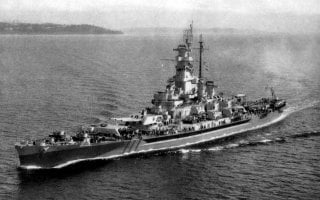USS Massachusetts Made History in Both World War II Theaters
USS Massachusetts served everywhere from Operation Torch to Okinawa.
Here's What You Need to Know: USS Massachusetts returned to the United States after the war, and decommissioned in 1947. It would remain in reserve for fifteen years. Fortunately, a group of veterans raised enough money to preserve it as a museum ship. The U.S. Navy began construction of its first fast battleships in 1937, with the two ships of the North Carolina class. The restrictions of the Washington and London Naval Treaties had imposed a battleship “holiday,” and mandated limits on the size of new warships. Treaty requirements limited displacement to thirty-five thousand tons, and (after Japan’s exit from the treaty triggered an escalator clause) gun size to sixteen inches. While intermediate plans had focused on relatively slow ships (around twenty-three knots), wargame experience and intelligence about the development of foreign ships made clear that this would prove far too slow, and designers eventually opted for a speed of twenty-seven knots. The U.S. Navy followed up the two in the North Carolina class with the four South Dakotas. Initial plans for the South Dakotas again called for a reduction in speed, which would allow them to operate with the older ships of the battle line. The question of speed spurred bitter disagreements between designers, officers, and strategists; eventually, intelligence about the battleships of the Imperial Japanese Navy helped carry the day for advocates of high speed. The resulting South Dakotas (“SoDaks”) were more heavily armored than the North Carolinas on a slightly smaller hull, but at the expense of weaker underwater protection, reduced crew space and an extremely cramped engineering section. The design probably attempted too much on a limited displacement, and the ships were never regarded as fully satisfactory. Nevertheless, the South Dakotas were extremely effective ships, the only ships to fulfill the Washington Naval Treaty requirements while carrying sixteen-inch guns, having protection against sixteen-inch shells and enjoying a speed of twenty-seven-plus knots. They also had a large and effective antiaircraft armament. Although classic interim ships, the architects of the SoDaks achieved great things within the imposed limits. Visually, the SoDaks were distinguished from both the Iowas and the North Carolinas by having one funnel instead of two, a choice that resulted in a sleek, streamlined appearance. USS Massachusetts, third of the class, was commissioned in May 1942, and five months later joined Operation Torch, the U.S. invasion of French North Africa. Although both British and American planners hoped that French resistance to the invasion would be minimal, a major French naval presence at Casablanca threatened to disrupt the operation. The French squadron at Casablanca included several large destroyers and the Jean Bart, an incomplete but mildly functional battleship that had escaped just prior to the Nazi conquest of France. Massachusetts and several escorts were detailed to subdue this force. On November 8, while supporting landings near Casablanca, Massachusetts came under fire from Jean Bart. Massachusetts replied, silencing Jean Bart with five hits. Massachusetts and its escorts then opened fire on and sank a pair of destroyers. French shore batteries inflicted superficial damage on Massachusetts, the scars of which are still evident on its decks today. Massachusetts had the first honor of surface combat against an enemy battleship of any American dreadnought, beating out its sister USS South Dakota and its cousin USS Washington at the Second Battle of Guadalcanal by six days. With the French subdued and the threats from the German and Italian fleets in decline, USS Massachusetts was dispatched to the Pacific, arriving in March 1943. The rest of its career would be consumed with carrier escort, convoy escort and shore bombardment. At the Battle of Leyte Gulf, Massachusetts was part of the force that narrowly missed engaging Adm. Takeo Kurita’s battleships off Samar Island. It and the carriers it escorted operated against Formosa, Kwajalein, Iwo Jima, Okinawa, and mainland Japan in 1944 and 1945. Its final mission was against an industrial complex at Hamamatsu on August 9, 1945, and many believe that the last sixteen-inch shell fired in anger in World War II came from Massachusetts. USS Massachusetts returned to the United States after the war, and decommissioned in 1947. It would remain in reserve for fifteen years. Because of cramped conditions on the South Dakotas, the Navy preferred to use Washington and North Carolina as training vessels. The slow speed of Massachusetts and its sisters (relative to the Iowa class) precluded their reactivation for the Korean War. In the late 1950s, the U.S. Navy began disposing of its remaining slow battleships, first the pre-war “Big Five,” then the four SoDaks and the two North Carolinas. Fortunately, activism on the part of veterans and state officials made it possible to save several of the ships. A group of veterans from Massachusetts put together a campaign to raise the money to save the battleship and convert it into a memorial. It was berthed at Battleship Cove in Fall River, Massachusetts in 1965, and remains there today. It rests alongside USS Joseph P. Kennedy, USS Lionfish, the former East German corvette Hiddensee and a pair of PT boats. Its sister, USS Alabama, was preserved at Mobile Bay, and its cousin, USS North Carolina, at Wilmington. Robert Farley, a frequent contributor to TNI, is author of The Battleship Book. He serves as a Senior Lecturer at the Patterson School of Diplomacy and International Commerce at the University of Kentucky. His work includes military doctrine, national security, and maritime affairs. He blogs at Lawyers, Guns and Money and Information Dissemination and The Diplomat. This article first appeared several years ago. Image: Wikipedia.

